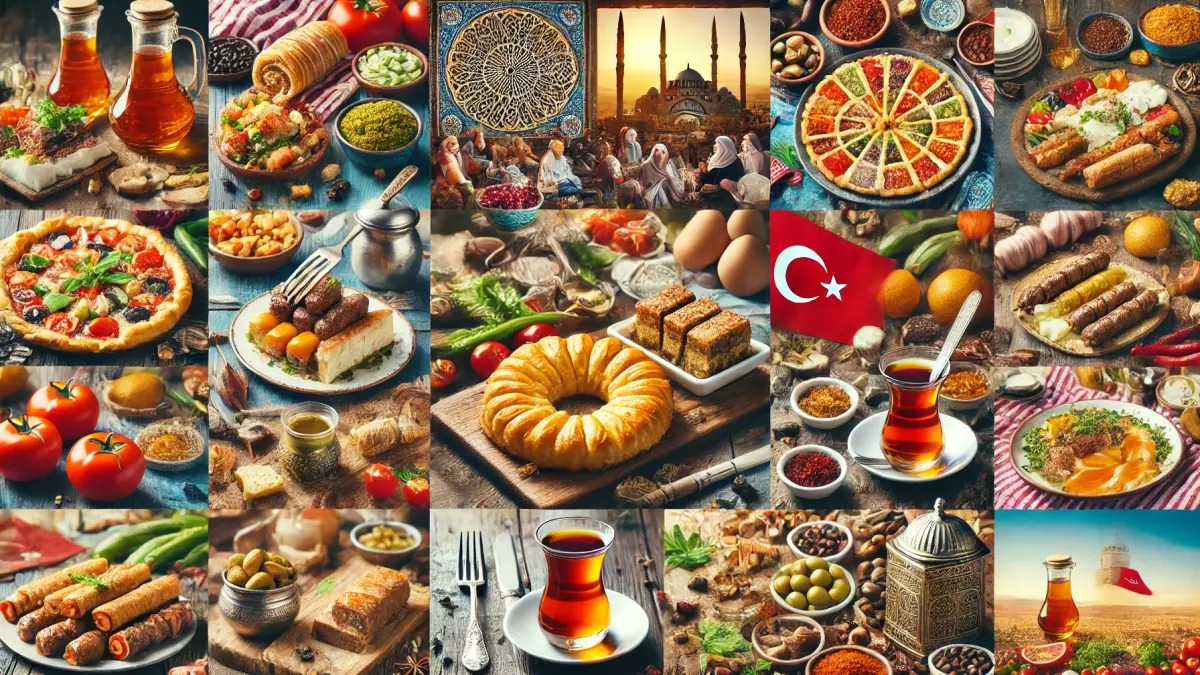Mardin, a city steeped in history and culture in southeastern Turkey, is not only a visual feast with its golden stone architecture and ancient landmarks but also a culinary treasure trove. The city’s cuisine is a reflection of its rich and diverse cultural heritage, with influences from Turkish, Kurdish, Arab, and Assyrian traditions. As you wander through Mardin’s narrow, winding streets, you are greeted by the tantalizing aromas of spices, grilled meats, and freshly baked bread, inviting you to embark on a culinary journey like no other. In this article, we will explore the distinctive flavors of Mardin’s cuisine, the traditional dishes that have been passed down through generations, and the cultural significance behind them.

The Unique Flavors of Mardin’s Cuisine
Mardin’s cuisine is a harmonious blend of flavors that have been influenced by the various cultures and civilizations that have called this region home over the centuries. The city’s location at the crossroads of the Middle East and Anatolia has resulted in a culinary tradition that is both diverse and rich in flavors. The use of spices is a defining characteristic of Mardin’s cuisine, with ingredients like sumac, cumin, coriander, and allspice adding depth and complexity to the dishes.
One of the most notable aspects of Mardin’s culinary tradition is the emphasis on communal dining. Meals are often enjoyed with family and friends, and food is seen as a way to bring people together. Whether it’s a simple meal at home or a lavish feast for a special occasion, the act of sharing food is deeply ingrained in the culture of Mardin.
Must-Try Dishes in Mardin
Mardin’s cuisine is as diverse as its history, with a wide variety of dishes that reflect the region’s rich cultural heritage. Here are some of the must-try dishes that you should not miss on your culinary journey through Mardin:
1. Kaburga Dolması (Stuffed Lamb Ribs)
Kaburga Dolması is one of the most iconic dishes of Mardin. This rich and flavorful dish consists of lamb ribs stuffed with a mixture of rice, minced meat, nuts, and spices, then slow-cooked to perfection. The result is a tender, aromatic dish that is bursting with flavor. Kaburga Dolması is often served on special occasions and is a symbol of hospitality and generosity in Mardin’s culture.
The preparation of Kaburga Dolması is a labor of love, requiring hours of slow cooking to ensure that the lamb is tender and the flavors are fully infused. This dish is a true representation of Mardin’s culinary artistry and is a must-try for anyone looking to experience the authentic flavors of the region.
2. İçli Köfte (Stuffed Meatballs)
İçli Köfte, also known as Kibbeh in other Middle Eastern cuisines, is a popular dish in Mardin that showcases the region’s skillful use of spices and ingredients. These meatballs are made from a mixture of bulgur wheat and minced meat, which is then stuffed with a spiced filling of minced lamb, onions, and nuts. The meatballs are either boiled or fried, resulting in a crispy exterior and a flavorful, juicy interior.
İçli Köfte is often served as an appetizer or as part of a mezze platter, but it can also be enjoyed as a main course. The combination of textures and flavors in İçli Köfte makes it a beloved dish in Mardin’s culinary tradition.
3. Mardin Çöreği (Mardin Bread)
Mardin Çöreği is a traditional bread that is an integral part of the local cuisine. This aromatic bread is made with a mixture of flour, water, and yeast, and is flavored with a variety of spices such as fennel, anise, and mahleb (a spice made from the seeds of the St. Lucie cherry). The bread is often shaped into large, round loaves and baked in a wood-fired oven, giving it a crispy crust and a soft, fragrant interior.
Mardin Çöreği is typically served with breakfast, accompanied by cheese, olives, and fresh herbs, but it can also be enjoyed throughout the day. The unique flavor of this bread makes it a staple in Mardin’s culinary landscape, and no visit to the city would be complete without trying it.
4. Sembusek (Mardin-Style Meat Pies)
Sembusek is a popular street food in Mardin, and it’s easy to see why. These delicious meat pies are made from thin, crispy dough that is stuffed with a mixture of minced meat, onions, and spices, then baked to golden perfection. The result is a savory pastry that is both crunchy and flavorful, making it the perfect snack or light meal.
Sembusek is often enjoyed with a side of ayran (a refreshing yogurt drink) or a cup of hot tea. The simplicity of this dish, combined with its rich flavors, makes it a favorite among locals and visitors alike.
5. Soğan Kebabı (Onion Kebab)
Soğan Kebabı is a unique and flavorful dish that is a testament to the creativity of Mardin’s cuisine. This dish consists of small onions that are hollowed out and stuffed with a mixture of minced meat, spices, and sometimes bulgur. The stuffed onions are then skewered and grilled over an open flame, resulting in a smoky, tender dish with a sweet and savory flavor.
Soğan Kebabı is typically served with flatbread and a side of yogurt, making it a satisfying and hearty meal. The combination of the smoky grilled onions and the spiced meat filling makes this dish a true delight for the taste buds.
6. Harire (Mardin-Style Pudding)
No culinary journey through Mardin would be complete without trying Harire, a traditional pudding that is often served during special occasions and religious festivals. Harire is made from a mixture of grape molasses, flour, and spices such as cinnamon and cloves, which are cooked together until thick and smooth. The pudding is then garnished with nuts and raisins, adding texture and sweetness to the dish.
Harire is a comforting and satisfying dessert that reflects the rich flavors and culinary traditions of Mardin. The use of grape molasses gives the pudding a deep, caramel-like flavor, while the spices add warmth and complexity.
7. Kibe (Mardin-Style Meat and Wheat Dish)
Kibe is a traditional dish in Mardin that is often prepared for special occasions and family gatherings. This dish is made from a mixture of bulgur wheat, minced meat, and a variety of spices, which are cooked together to create a hearty and flavorful meal. The dish is often served with a side of yogurt and fresh herbs, making it a complete and satisfying meal.
Kibe is a dish that is deeply rooted in Mardin’s culinary tradition, and it reflects the importance of communal dining and the sharing of food in the region’s culture. The rich flavors and textures of Kibe make it a favorite among locals and visitors alike.
The Cultural Significance of Mardin’s Cuisine
Mardin’s cuisine is more than just a collection of delicious dishes; it is a reflection of the city’s history, culture, and way of life. The traditional dishes of Mardin have been passed down through generations, with each family adding their own unique touch to the recipes. Food is an integral part of life in Mardin, and it plays a central role in bringing people together.
One of the most important aspects of Mardin’s culinary tradition is the emphasis on hospitality. In Mardin, food is seen as a way to show generosity and kindness to others. Guests are often welcomed with a lavish spread of dishes, and no meal is complete without the sharing of food and conversation. This emphasis on hospitality is a reflection of the region’s cultural values, where community and family are at the heart of daily life.
Mardin’s cuisine is also a reflection of the region’s agricultural heritage. The ingredients used in traditional dishes are often locally sourced, with fresh produce, herbs, and spices playing a central role in the preparation of meals. The use of local ingredients not only adds flavor to the dishes but also helps to preserve the region’s agricultural traditions.
A Culinary Experience Like No Other
A culinary journey through Mardin is an experience like no other, offering a taste of the rich cultural and culinary heritage of southeastern Turkey. From the savory flavors of Kaburga Dolması and İçli Köfte to the sweet and comforting taste of Harire, Mardin’s cuisine is a celebration of the region’s history, culture, and traditions.
Whether you’re dining in a local restaurant, enjoying street food, or sharing a meal with a Mardin family, you’ll find that food in Mardin is more than just sustenance; it’s a way of life. The flavors, aromas, and textures of Mardin’s cuisine will stay with you long after your journey has ended, leaving you with memories of a city that is as rich in flavor as it is in history.
So, as you explore the streets of Mardin, take the time to savor the culinary delights that the city has to offer. Each dish, each flavor, is a window into the soul of Mardin, offering a glimpse into the traditions and cultures that have shaped this unique and vibrant city.




